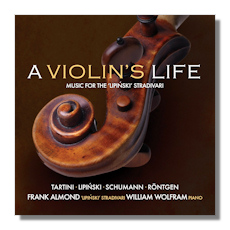
The Internet's Premier Classical Music Source
Related Links
-
Röntgen Reviews
Schumann Reviews
Tartini Reviews - Latest Reviews
- More Reviews
-
By Composer
-
Collections
DVD & Blu-ray
Books
Concert Reviews
Articles/Interviews
Software
Audio
Search Amazon
Recommended Links
Site News
 CD Review
CD Review
A Violin's Life

Music for the "Lipiński" Stradivari
- Giuseppe Tartini: Sonata in G minor "il trillo del Diavolo"
- Julius Röntgen: Violin Sonata #2 in F Sharp Major, Op. 20
- Karol Lipiński: Caprice, Op. 29 #3
- Robert Schumann: Violin Sonata #2 in D minor, Op. 121
Frank Almond, violin
William Wolfram, piano
"Lipiński" Stradivari Violin made in 1715
Steinway Model D Concert Grand Piano
Notes by John Dilworth, maker and restorer of string instruments
Avie AV2279 DDD 61:41
"The Devil's Trill" is surely the best-known work of Giuseppe Tartini (1602-1770). Reportedly inspired by a dream this baroque composer had, it has always been found very difficult by performers. It contains double stop chords for one thing, as do the other works on this disc. Almond, and Wolfram, the latter serving as the originally scored ground bass, produce a skillful and fine-sounding version of the work. The trill in the title comes toward the end of the three-movement sonata. Tartini was – as far as we know – the original owner of the violin played in this recording. Lipinski, whose name has been attached to the instrument, acquired it soon after, by way of his teacher, Salvini, who had been given it by Tartini. Salvini reportedly smashed the inferior violin Lipiński brought to a lesson!
Julius Röntgen (1855-1932), a friend of Brahms and Grieg, acquired ownership of this violin a few years after Lipinski's death in 1861, inheriting it in 1897 from his father, Concertmaster of the Leipzig Gewandhaus orchestra. In the interim, a violin maker named Richard Weichold "modernized" it with adjustments to the fingerboard and neck of the instrument, resulting in the greater power and range desired by musicians at that time.
The Röntgen sonata was an early work of this long-lived composer. In the course of his career he moved from Leipzig to Amsterdam and became a Dutch citizen after the First World War. He wrote hundreds of works, including symphonies and concertos, several of which I have reviewed on this site. His second Violin Sonata is in three movements, mostly fast.
The Caprice by Karol Lipinski (1790-1861) was dedicated to Paganini, and seems to have been inspired by the caprices of that composer.
Robert Schumann's Second Violin Sonata, in four movements, the longest piece in this collection at a little over a half-hour, was one of his late works There are dozens, even scores, of recordings of it, and I cannot make an informed comparison of this vast number – which attests to its popularity – but I do not think that this performance will disappoint.
This recording is well worth acquiring simply for these works and performances, but it was produced (with the help of Kickstarter donors) to celebrate the distinctive qualities and distinguished history of an exceptional three hundred year old violin. Fortunately the recording was well done, miked at just the right distance so as to bring across the full sound of the lower notes without shrillness in the upper register of the violin. The balance between the violin and the piano is fine also.
The violin was made during Antonio Stradivari's "golden period." Its physical dimensions provide extra resonance in its lower range and its design also gives it carrying power with precision and subtlety without loss of clarity and focus over its full range. Frank Almond has noted that bringing out the full capabilities of the instrument was something that took acquaintance with it over an extended period.
This is the violin which gained international publicity when it was stolen in the course of a violent attack on the violinist as he was on the way to his car following a concert, and recovered just a few days later through exceptional investigative work by the police and FBI. The recording was made several months prior to these events.
Frank Almond is the Concertmaster of the Milwaukee Symphony Orchestra. He plays the Lipiński through the generosity, civic pride and sheer love of music on the part of its anonymous owner, who lent it to Almond on an indefinite basis. In addition to serving as Concertmaster in Milwaukee, Almond heads a Milwaukee chamber music group called Frankly Music and belongs to another in New York City called An die Musik (which has had two Grammy nominations). He studied with Dorothy DeLay at Juilliard and was a prizewinner in more than one international competition. He served as guest Concertmaster under Gergiev and Kurt Mazur. He has been soloist internationally also and has several other recordings.
William Wolfram also has an international reputation, as a silver and bronze medalist at important international competitions, and as soloist with many orchestras. He has several recordings also.
This is a very interesting and appealing recording. Recommended.
Copyright © 2014, R. James Tobin




















